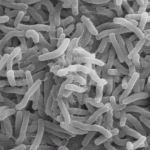Microbiology
|
12 october 2014 06:23:01 |
| Identification of glycoproteins secreted by wild-type Botrytis cinerea and by protein O -mannosyltransferase mutants (BMC Microbiology) |
|
Tweet Background:
Botrytis cinerea secretes a high number of proteins that are predicted to have numerous O-glycosylation sites, frequently grouped in highly O-glycosylated regions, and analysis of mutants affected in O-glycosylation has shown, in B. cinerea and in other phytopathogenic fungi, that this process is important for fungal biology and virulence.
Results:
We report here the purification of glycoproteins from the culture medium, for a wild-type strain of B. cinerea and for three mutants affected in the first step of O-glycosylation, and the identification of components in the purified protein samples. Overall, 158 proteins were identified belonging to a wide diversity of protein families, which possess Ser/Thr-rich regions (presumably highly O-glycosylated) twice as frequently as the whole secretome. Surprisingly, proteins predicted to be highly O-glycosylated tend to be more abundant in the secretomes of the mutants affected in O-glycosylation than in the wild type, possibly because a correct glycosylation of these proteins helps keep them in the cell wall or extracellular matrix. Overexpression of three proteins predicted to be O-glycosylated in various degrees allowed to confirm the presence of mannose ?1-2 and/or ?1-3 bonds, but no mannose ?1-6 bonds, and resulted in an enhanced activity of the culture medium to elicit plant defenses.
Conclusions:
Glycosylation of secretory proteins is very prevalent in B. cinerea and affects members of diverse protein families. O-glycosylated proteins play a role in the elicitation of plant defenses. |
| 127 viewsCategory: Microbiology |
 A novel Bacillus pumilus -related strain from tropical landfarm soil is capable of rapid dibenzothiophene degradation and biodesulfurization (BMC Microbiology) A novel Bacillus pumilus -related strain from tropical landfarm soil is capable of rapid dibenzothiophene degradation and biodesulfurization (BMC Microbiology)In vitro combination therapy using low dose clotrimazole and photodynamic therapy leads to enhanced killing of the dermatophyte Trichophyton rubrum (BMC Microbiology) 
|
| blog comments powered by Disqus |
MyJournals.org
The latest issues of all your favorite science journals on one page
The latest issues of all your favorite science journals on one page



